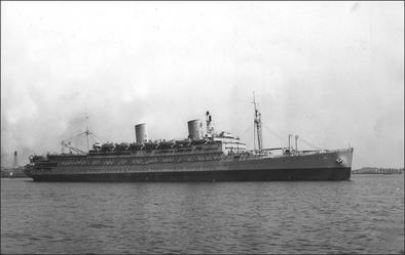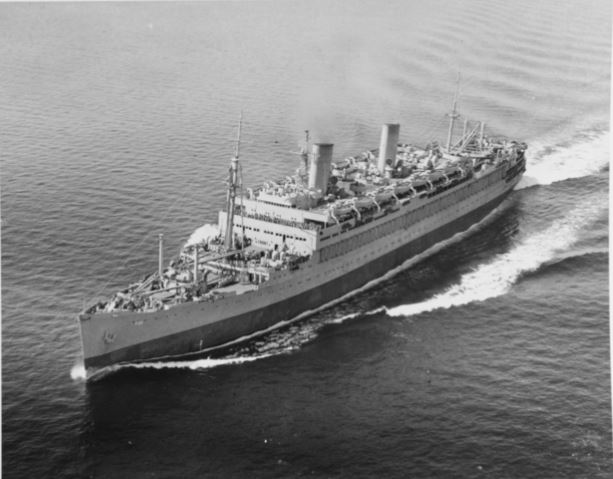Difference between revisions of "USS Mount Vernon (AP 22)"
From Our Contribution
| (8 intermediate revisions by the same user not shown) | |||
| Line 1: | Line 1: | ||
{{Infobox ship | {{Infobox ship | ||
| − | | image = [[File: | + | | image = [[File:USS_Mount_Vernon.jpg]] |
| caption = | | caption = | ||
| − | | image2 = [[File:.jpg]] | + | | image2 = [[File:USS_Mount_Vernon_1.jpg]] |
| caption2 = | | caption2 = | ||
| shipname = USS Mount Vernon (AP-22) | | shipname = USS Mount Vernon (AP-22) | ||
| Line 19: | Line 19: | ||
| shiptype = Ocean Liner / Troop Transport | | shiptype = Ocean Liner / Troop Transport | ||
| shiptonnage = 24,289 tons | | shiptonnage = 24,289 tons | ||
| − | | shiplength = 705 ft 3 in | + | | shiplength = 705 ft 3 in (214.96m) |
| − | | shipbeam =86 ft | + | | shipbeam =86 ft (23.62m) |
| − | | shipdepth = draft 31 ft 6 in | + | | shipdepth = draft 31 ft 6 in (9.6m) |
| shippropulsion = twin screw | | shippropulsion = twin screw | ||
| − | | shipspeed = 20.5 knots | + | | shipspeed = 20.5 knots(38 km/h) |
| shipcapacity = crew of 766, carrying 6,031 troops | | shipcapacity = crew of 766, carrying 6,031 troops | ||
}} | }} | ||
| Line 32: | Line 32: | ||
| − | The Mount Vernon was a fast converted liner and often did not travel with convoys at their slower speeds. The crew feared sub attacks because, they traveled alone and did not zig zag much. WHen Pearl Harbour was invaded she was off Cape Town and continued to Singaapore, arriving on 13 Jan 1942, and leaving there on 16 Jan 1942 ahead of the Japanese arrival. She acted as the lead ship in the Operation | + | The Mount Vernon was a fast converted liner and often did not travel with convoys at their slower speeds. The crew feared sub attacks because, they traveled alone and did not zig zag much. WHen Pearl Harbour was invaded she was off Cape Town and continued to Singaapore, arriving on 13 Jan 1942, and leaving there on 16 Jan 1942 ahead of the Japanese arrival. She acted as the lead ship in the ''Operation Stepsister'' Convoy that returned Australian soldiers from the Middle East to Adelaide. |
| + | For the next two years, ''Mount Vernon'' plied from San Francisco to ports in Australia, New Zealand, New Caledonia, and Hawaii, carrying the men who would build the bases, and then fight from them. Her last such voyage began from San Francisco on 21 Feb 1944. Steaming via Melbourne, she proceeded to Bombay, India, to disembark Army personnel before returning to Melbourne,before sailing for Boston via the Panama Canal, arriving there on 22 May 1944. | ||
| + | |||
| + | On 4 June 1944, ''Mount Vernon'' began a series of voyages to British Isles ports and the Mediterranean, carrying men for the massive buildup associated with landings in Europe. She continued after the war, as she carried occupation troops over to Europe and returned veterans home. | ||
Armament | Armament | ||
| Line 43: | Line 46: | ||
==Soldiers carried== | ==Soldiers carried== | ||
| + | |||
| + | ===Sydney to England via the USA 11 August - 16 October 1943=== | ||
| + | * † [[Greer Winton Ottaway]] RAAF | ||
[[Category:Ships]] | [[Category:Ships]] | ||
Latest revision as of 20:41, 11 December 2023
Remarks
A troop transport that served with the United States Navy during World War II. Prior to her military service, she was a luxury ocean liner named SS Washington. Washington was launched in May 1933 by the New York Shipbuilding Company, and operated as a passenger liner from New York City to Plymouth, England, and Hamburg, Germany. Renamed Mount Vernon on 6 June 1941, the liner was acquired by the Navy 16 June 1941 and commissioned at the Philadelphia Navy Yard.
The Mount Vernon was a fast converted liner and often did not travel with convoys at their slower speeds. The crew feared sub attacks because, they traveled alone and did not zig zag much. WHen Pearl Harbour was invaded she was off Cape Town and continued to Singaapore, arriving on 13 Jan 1942, and leaving there on 16 Jan 1942 ahead of the Japanese arrival. She acted as the lead ship in the Operation Stepsister Convoy that returned Australian soldiers from the Middle East to Adelaide.
For the next two years, Mount Vernon plied from San Francisco to ports in Australia, New Zealand, New Caledonia, and Hawaii, carrying the men who would build the bases, and then fight from them. Her last such voyage began from San Francisco on 21 Feb 1944. Steaming via Melbourne, she proceeded to Bombay, India, to disembark Army personnel before returning to Melbourne,before sailing for Boston via the Panama Canal, arriving there on 22 May 1944.
On 4 June 1944, Mount Vernon began a series of voyages to British Isles ports and the Mediterranean, carrying men for the massive buildup associated with landings in Europe. She continued after the war, as she carried occupation troops over to Europe and returned veterans home.
Armament
- 4 × 5"/38 caliber guns
- 4 × 3"/50 caliber guns
- 8 × 0.5 in (12.7 mm) machine guns
Soldiers carried
Sydney to England via the USA 11 August - 16 October 1943
- † Greer Winton Ottaway RAAF

